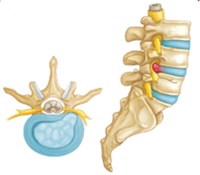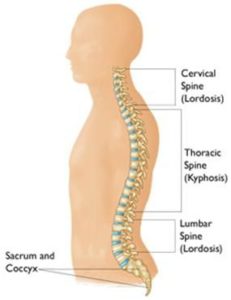Disc Injury – What is all the fuss about?
 I’ll tell you what I’m doing right now: I am lying on the floor of my lounge room waiting for my L5 disc injury to settle down.
I’ll tell you what I’m doing right now: I am lying on the floor of my lounge room waiting for my L5 disc injury to settle down.
My Story.
So here I am.
I cancelled a very full day of patients on Friday. I am unable to stand upright for more than a few minutes. And it’s all because of this little suspicious tweak I felt about midday Thursday. I type as lie on my front on the floor with a few pillows under my chest. Exactly the position I have instructed numerous patients over the years to adopt for relief from disc injury.
What has actually happened?
Somewhere in the 20 years of high intensity basketball, leaping about, I reckon I did some damage to my lower back. Or perhaps it was from lifting some filing cabinet – you know the one that should have been emptied before lifting – I don’t know.
What I do know is that over the last five or so years, as life has become a bit more sedentary, I have had three or four episodes where my body has gone into shutdown.
What is a disc injury?
In my case, I have an old injury in my fourth or fifth lumbar disc. I know this because I get some mild nerve pain in my leg that corresponds to nerves that arise from those particular discs.
 Discs are the flexy, shock absorbers that sit between the vertebral bones in our spine. They are a brilliant design, made up of a tough flexible outer wall encasing a vacuum-packed ball of fluid. This effectively acts like a friction-free ball bearing for effortless movement.
Discs are the flexy, shock absorbers that sit between the vertebral bones in our spine. They are a brilliant design, made up of a tough flexible outer wall encasing a vacuum-packed ball of fluid. This effectively acts like a friction-free ball bearing for effortless movement.
Like every other part of our body, discs encounter degenerative change over years. If you have injured a disc at some point, then the degenerative change caused by ageing will be somewhat more advanced in that particular disc.
This is the case with me.
My fourth or fifth lumbar disc will be harbouring some degree of injury 24/7.
Shouldn’t it hurt all the time?
Thankfully no.
Here’s the thing. Your body will ignore old disc damage most of the time. The only time it will shut you down is if you load that injured disc. The body will say to itself, ‘Arghh (yes the body actually says Arghh) danger! We cannot afford more damage there, that structure is critical.’
So it shuts you down for repair.
The body goes into repair mode so it can fix what we know was broken, so to speak. We also know that the body will not successfully repair disc material, but it is going to have a fair crack at it.
What does shut down for repair look like?
Painful.
Firstly…
The body sends healing agents to the area. Inflammation is a healing response that brings with it all sorts of little repair goodies that go to work at a microscopic level trying to repair the disc.
Secondly…
The body immobilises the area. A lot like when you break a bone, the body wants to shut down movement and load on that structure for a time. The only problem with the lower back is that you use it for just about everything, even sneezing as some of you will be able to relate to.
The body successfully immobilises the lower back by causing muscle spasms. Now these are scary. Most people who experience these for the first time are convinced they will never walk again. With an acutely inflamed lower lumbar disc, when you stand upright you place vertical load on it, thanks to gravity. In my case, my back can tolerate this for a few ginger steps before spasming in such a way that dropping to all fours becomes my only option.
If you decide you have the mental fortitude to ignore this pain, your body quickly forces you to take on its priorities. If spasming pain is not enough, it literally shuts down your legs. They go paralytically weak. No mental fortitude seems to beat this.
 Thirdly…
Thirdly…
The body communicates, via pain, which postures it prefers and which postures it wants you to avoid. In the case of the lower lumbar spine, the optimum posture for the discs is when you have a nice curve evenly present throughout all five lumbar vertebrae. This is called a lordosis.
Any attempt to change this curve leads to, you guessed it, muscle spasms.
So for example, when you sit in a normal chair, but especially a low chair or as some of you know – a toilet seat, you cannot help but reverse this curve. The lower spine flattens or even flexes in the opposite direction, depending on the seat. This invites a somewhat vigorous response like that of a drill sergeant that screams: Get up, get off, get on the damn floor!
Why does the body shut down?
The body shuts down like this to do you a favour. Now we think that loss of productivity is no favour at all, but your body knows that if you do not take this three to seven days’ to rest, you risk a lifetime of chronic pain. In other words the body knows that if it does not take the time to repair here, the damage will increase to the point that a wheelchair is required.
So the body is in fact doing you a favour. Don’t fight it.
What do I do about it?
Now in my example I have virtually no pain as long as my spine is in its preferred posture. As I lie on the floor and write this, I feel like a bit of a phoney. I missed work and all that is present right now is a mild, dull ache. But as I have found in trying to get the body moving, once I get to twenty paces, I am hands-on-knees trying to control the spasming pain and avoid meeting the ground.
The dogs now hate me as I have, in my optimism, tried to walk them a few times and got as far as the end of the driveway!
So the solution is: do what your body is telling you to do.
My instruction list is contained in the article, ‘Lower back pain – rule of 10s’, so I won’t repeat it here.
I must say, as a therapist who has treated many of these cases over the years, that until the body has finished its own course of repair, there is very little a therapist can do for you. I cannot switch off the inflammation. And as long as the inflammation is present I cannot switch off the muscle spasms.
Follow the 10 minute rules, which should have you up and about within 3-10 days. Once you are moving get in to see your Myotherapist to find out if there are any residual muscular restrictions. They will also either give you, or refer you for, some strengthening exercises. These will help protect that spine and prevent a reoccurrence.
SHARE THIS WITH YOUR PATIENTS NOW


